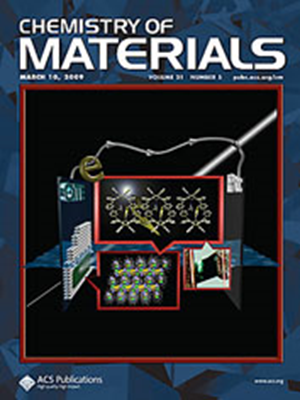Pressure-Induced Conglomerate to Racemate Transformation in a One-Dimensional Disulfide-Based Lead Halide
IF 7.2
2区 材料科学
Q2 CHEMISTRY, PHYSICAL
引用次数: 0
Abstract
Controlling the molecular chirality under external pressure is particularly challenging in low-dimensional hybrid halides, as the constrained structure and strong hydrogen bonding hinder significant conformational changes in bulky organic molecules. Here, by incorporating flexible disulfide-based molecules into the one-dimensional (1D) PbI5 framework, the chiral hybrid halide [NH3(CH2)2S–S(CH2)2NH3]PbI5·H3O undergoes a transformation from conglomerate to racemate at a hydrostatic pressure of approximately 0.10 GPa. This reversible acentric-to-centric transformation is accompanied by the second-harmonic generation (SHG) “on–off” switching and significant conformational changes in the cystamine cations within the structure. In the high-pressure racemic phase, two enantiomers with left- and right-handed conformers (M- and P-helicity) coexist within the lattice structure and their deformations under compression resemble those of a compressed mechanical spring, ultimately leading to considerable distortions of the 1D zigzag PbI5 chains through strong organic–inorganic H···I interactions. Furthermore, both experimental and theoretical results reveal that the unique phase transformation induces minor alterations in the electronic structures and optical bandgaps. Our findings provide insights into the manipulation of molecular chirality and SHG properties in hybrid halides by introducing flexible organic molecules into inorganic frameworks.

求助全文
约1分钟内获得全文
求助全文
来源期刊

Chemistry of Materials
工程技术-材料科学:综合
CiteScore
14.10
自引率
5.80%
发文量
929
审稿时长
1.5 months
期刊介绍:
The journal Chemistry of Materials focuses on publishing original research at the intersection of materials science and chemistry. The studies published in the journal involve chemistry as a prominent component and explore topics such as the design, synthesis, characterization, processing, understanding, and application of functional or potentially functional materials. The journal covers various areas of interest, including inorganic and organic solid-state chemistry, nanomaterials, biomaterials, thin films and polymers, and composite/hybrid materials. The journal particularly seeks papers that highlight the creation or development of innovative materials with novel optical, electrical, magnetic, catalytic, or mechanical properties. It is essential that manuscripts on these topics have a primary focus on the chemistry of materials and represent a significant advancement compared to prior research. Before external reviews are sought, submitted manuscripts undergo a review process by a minimum of two editors to ensure their appropriateness for the journal and the presence of sufficient evidence of a significant advance that will be of broad interest to the materials chemistry community.
 求助内容:
求助内容: 应助结果提醒方式:
应助结果提醒方式:


